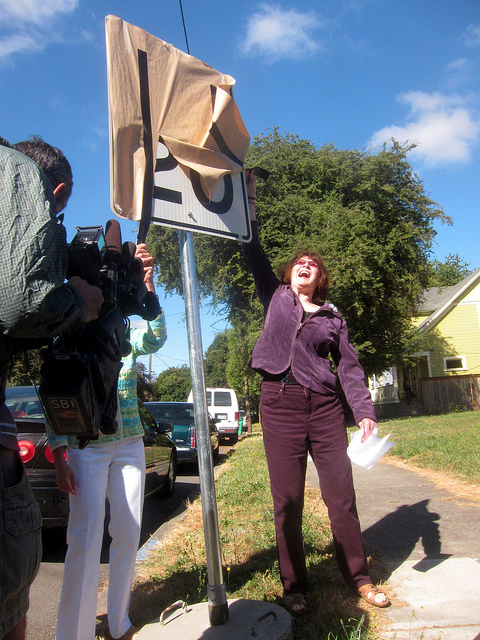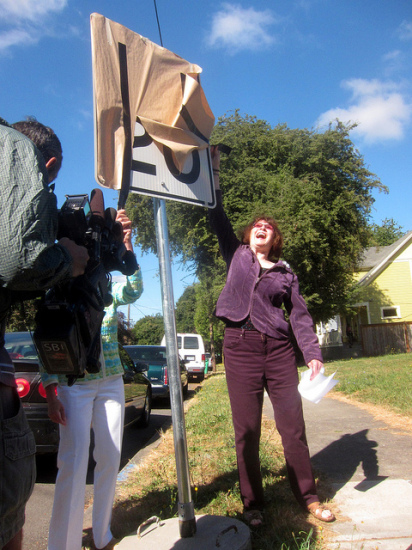Last week, I outlined some of the key principles of Vision Zero—an approach to designing streets that prioritizes safety and human life above other considerations. Today, the city of Portland rolled out its Vision Zero commitments, including an ambitious goal of working toward zero traffic deaths and serious injuries within the next decade.
Over the next two years, the city plans to lay the foundation for lowering speed limits on certain types of city streets, identify five new or upgraded neighborhood greenways, improve safety along four high-crash corridors, inventory sidewalk gaps, install a total of 18 flashing crosswalk beacons to help walkers safely cross East Portland streets, study the feasibility of five protected bikeways on busy corridors, install 10 new automated cameras to catch people running red lights, and seek legislative authority to install unmanned radar cameras to ticket speeders (which the city can’t legally do now).
Compared to New York City’s comprehensive Vision Zero rollout last year, Portland’s plan doesn’t feel so ambitious or integrated. But the Portland Bureau of Transportation has struggled with years of budget cuts, and officials said they wanted to craft a two-year work plan that is realistic given the city’s finances. It “outlines approaches and actions that can be taken with existing resources and scaled up as new revenue becomes available,” the city said.
The city also reiterated its goal of having 80 percent of residents live within a 1/2 mile of a low-stress, traffic-calmed, family-friendly street network where people feel safe to walk, bike, play, or socialize without competing with speeding cars.
Although Portland’s traffic fatality rate is among the lowest for large American cities, it hasn’t made much progress in reducing those numbers in the last 20 years. During that time span, an average of 37 Portlanders died in traffic crashes annually. On average, 12 people walking and 2 people biking were killed each year.
That’s why the Portland Bureau of Transportation (PBOT) decided to make Vision Zero a key plank of a two-year workplan released this week, which outlines the city’s commitments to making the city’s transportation system work for ever greater numbers of people. It outlines action items in key areas: maintenance and preservation, Vision Zero, investing in a more complete network, ensuring existing streets work for many users, improving Portlanders’ health and the environment, and shoring up internal strengths and systems.
Vision Zero holds that even one traffic death is too many and that each fatality or serious injury reflects a failure in a transportation system. Its principles have been formally adopted by New York City, San Francisco, Chicago, and Los Angeles, and now Portland.
In Portland, here are some of the key action items in four areas:
Design Safer Streets
To reach its Vision Zero target, the city says “every street project should be designed to achieve zero deaths and serious injuries.” That means that street designs should physically eliminate conflicts between different users—people biking, people driving trucks, people riding scooters or motorcycles, people in wheelchairs, people walking, people driving cars—or ensure that if a collision occurs it won’t be fatal or serious. The city plans to prioritize projects that reduce speeds, “tame” arterial streets where most serious crashes occur, and provide protection for people crossing streets. Projects include:
- Develop an “Experimental Speed Zone Process” that will allow PBOT to evaluate and petition the state to lower speed limits on certain types of streets, rather than having to apply street by street. If approved, the city will comprehensively evaluate speeds on all collector and arterial streets in East Portland.
- Research bike-streetcar safety solutions
- Establish criteria for installing safe pedestrian crossings
- Use state funds to install a total of 18 flashing crosswalk beacon signals across East Portland
- Make safety improvements to four high-crash corridors by 2017
- Seek funding and target safety improvements along high-crash corridors in low-income areas of the city
- Assess who is using the city’s network of traffic-calmed, family-friendly streets and make recommendations for five new or upgraded neighborhood greenways by 2016
- Maintain at least four miles of neighborhood greenways each year
- Inventory all sidewalk gaps on collector streets and use this to target sidewalk investments
- Use techniques that eliminate intersection crashes between cars and people biking, including signals that give bicycles priority and timing that gives cyclists a “wave” of green traffic lights
Build Streets That Protect Everyone
The city’s also wants streets that work for everyone, including toddlers, retirees, those with mobility limitations or sensory impairments, or immigrants who speak different languages. Because these “most vulnerable” populations overwhelmingly rely on walking, biking, and transit to get around the city, it’s imperative that streets are safe for them too. Projects include:
- Make sure all city rights-of-way are accessible to persons with disabilities
- Evaluate the performance of new disabled parking regulations
- Expand the Safe Routes to Schools program to work with all public middle and elementary schools in the city, and explore expanding the program into 10 high schools in 2016
- Create walkable neighborhoods where Portland residents can easily and safely walk or bicycle to meet their basic, non-work needs
- Write a comprehensive Vision Zero plan and complete a safety report and accessible dashboard every two years
Teach Portlanders to Travel Together
According to the Vision Zero chapter of PBOT’s work plan, “a safe multi-modal transportation system requires a social compact in which all modes agree to follow the rules with patience and tolerance.” Toward that end, the city plans to:
- Explore funding for a joint safety education and awareness campaign with police and fire departments
- Get for-hire transportation vehicles, such as taxis, to display “Look Before You Open” stickers to prevent people biking from being hit by car doors
- Select three specific audiences (teens, freight carriers, people walking, speeding drivers, drinkers, people biking, people texting, etc.) to target for safety messages each year
Enforce Safe Behavior
Because design and education alone won’t ensure a safe system, the Portland Bureau of Transportation and Portland Police plans to develop shared safety priorities and strategies. But as other cities that have implemented Vision Zero have learned, automated enforcement that doesn’t require pulling a police officer from other duties can be hugely effective and even welcomed. That’s why Portland plans to:
- Work with the city’s government relations department and Portland Police to petition the Oregon Legislature to allow the city to use unmanned radar cameras to catch speeders
- Expand red light camera enforcement to 10 new locations.








